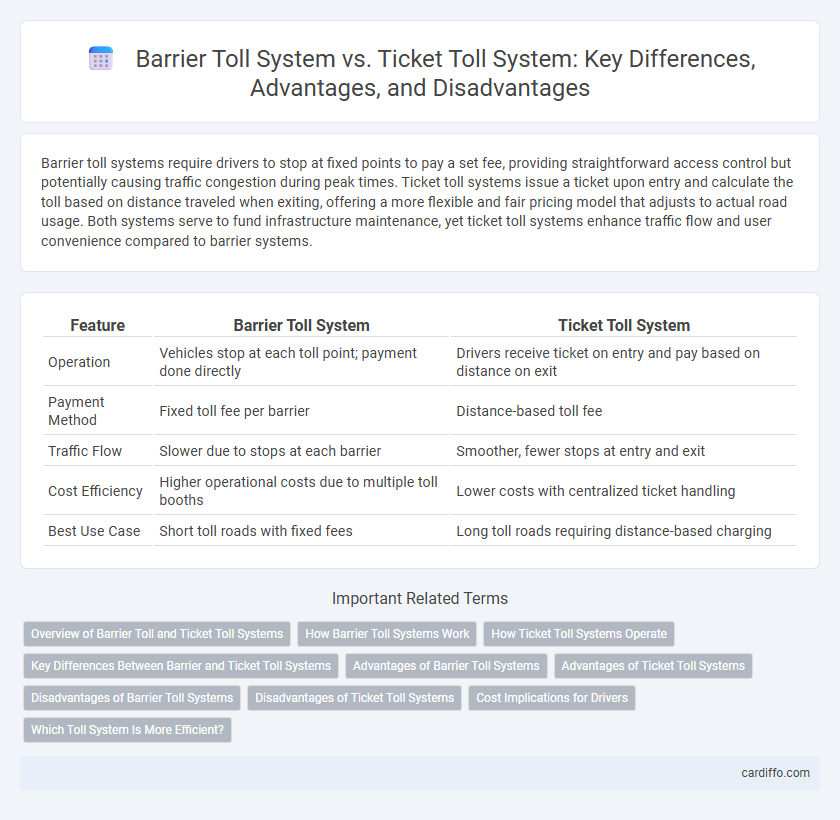Barrier toll systems require drivers to stop at fixed points to pay a set fee, providing straightforward access control but potentially causing traffic congestion during peak times. Ticket toll systems issue a ticket upon entry and calculate the toll based on distance traveled when exiting, offering a more flexible and fair pricing model that adjusts to actual road usage. Both systems serve to fund infrastructure maintenance, yet ticket toll systems enhance traffic flow and user convenience compared to barrier systems.
Table of Comparison
| Feature | Barrier Toll System | Ticket Toll System |
|---|---|---|
| Operation | Vehicles stop at each toll point; payment done directly | Drivers receive ticket on entry and pay based on distance on exit |
| Payment Method | Fixed toll fee per barrier | Distance-based toll fee |
| Traffic Flow | Slower due to stops at each barrier | Smoother, fewer stops at entry and exit |
| Cost Efficiency | Higher operational costs due to multiple toll booths | Lower costs with centralized ticket handling |
| Best Use Case | Short toll roads with fixed fees | Long toll roads requiring distance-based charging |
Overview of Barrier Toll and Ticket Toll Systems
Barrier toll systems utilize physical gates to control vehicle access, requiring drivers to stop and pay tolls manually or electronically at each booth. Ticket toll systems issue a ticket upon entry and calculate the toll fee based on the distance traveled when the ticket is surrendered at the exit. Both systems aim to manage traffic flow and toll collection efficiently, with barrier systems often implemented on shorter routes and ticket systems favored for longer highways.
How Barrier Toll Systems Work
Barrier toll systems operate by physically blocking the roadway with a barrier gate that lifts once a vehicle pays the toll, either manually at a staffed booth or automatically via electronic payment methods like RFID tags or license plate recognition. These systems ensure that toll collection occurs before the vehicle proceeds, reducing toll evasion and providing immediate transaction confirmation. The integration of automatic barrier sensors enhances traffic flow efficiency while maintaining secure toll enforcement on highways or bridges.
How Ticket Toll Systems Operate
Ticket toll systems operate by issuing a ticket to drivers upon entry, recording the point of access on the ticket. The toll amount is calculated based on the distance traveled between the entry and exit points when the ticket is surrendered at the exit toll plaza. This system ensures precise toll collection by correlating the vehicle's entry location with the exit point for accurate fare computation.
Key Differences Between Barrier and Ticket Toll Systems
Barrier toll systems require vehicles to stop at a gate where payment is collected before proceeding, ensuring controlled access but potentially causing delays during peak hours. Ticket toll systems provide drivers with a ticket upon entry and calculate the toll based on distance traveled, promoting continuous flow and reducing congestion. While barrier systems are simpler and suitable for short routes, ticket systems offer more accurate tolling for longer trips by charging users proportionally to their usage.
Advantages of Barrier Toll Systems
Barrier Toll Systems offer faster vehicle processing by allowing drivers to pay at multiple lanes simultaneously, reducing congestion at toll plazas. These systems provide enhanced security through physical barriers that prevent evasion, ensuring accurate toll collection. Maintenance costs tend to be lower compared to ticket systems due to simpler infrastructure and fewer operational complexities.
Advantages of Ticket Toll Systems
Ticket toll systems offer precise fare calculation by recording entry and exit points, ensuring fair charges based on actual distance traveled. They reduce congestion at toll plazas by enabling electronic tracking and automated payments, enhancing traffic flow efficiency. This system also provides detailed data for traffic management and infrastructure planning, improving overall transportation network optimization.
Disadvantages of Barrier Toll Systems
Barrier toll systems often cause significant congestion as vehicles must stop at each toll point, leading to increased travel time and fuel consumption. Maintenance costs are higher due to the physical infrastructure required, such as barriers, gates, and staff-operated booths. Limited scalability and inflexibility prevent seamless integration with modern electronic toll collection technologies, reducing overall efficiency.
Disadvantages of Ticket Toll Systems
Ticket toll systems often cause traffic congestion due to slower processing times at toll plazas, leading to delays and increased fuel consumption. The reliance on physical tickets can result in lost or damaged tickets, causing disputes and additional administrative costs for toll operators. Maintenance and operational costs for ticket printers and barriers are higher compared to barrier toll systems, impacting overall efficiency and user experience.
Cost Implications for Drivers
Barrier toll systems typically require drivers to stop and pay a fixed fee, leading to higher operational costs passed onto users through toll booths and staffing. Ticket toll systems calculate charges based on distance traveled, offering potentially lower costs for short trips and greater fairness but requiring investment in electronic ticketing infrastructure. Drivers may experience varying expenses depending on trip length, with ticket systems generally providing cost savings for infrequent or short-distance travel.
Which Toll System Is More Efficient?
Barrier Toll Systems offer faster transaction times by allowing vehicles to pay at fixed booths, reducing congestion on busy highways. Ticket Toll Systems provide greater accuracy in toll collection by recording entry and exit points, enabling distance-based pricing and minimizing revenue loss. Efficiency depends on traffic volume and tolling goals, but Barrier Systems excel in shorter routes while Ticket Systems better suit longer, multi-exit roadways.
Barrier Toll System vs Ticket Toll System Infographic

 cardiffo.com
cardiffo.com